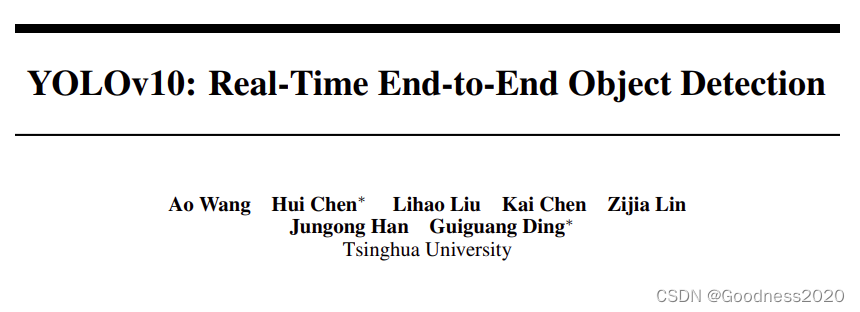一、前言
清华大学团队设计的Yolov10.

在这项工作中,我们主要从后处理和模型结构两方面进一步优化YOLO系列模型的性能和延迟平衡。我们首先为YOLO引入了端到端训练的一致双重分配,这在大大降低推理延迟的情况下保证了性能。此外,我们针对YOLO的各组件使用效率和精度驱动的模型设计策略。这大大减少了计算冗余,并增强了模型能力。
最终,我们获得了一个新的实时的端到端目标检测模型,即YOLOv10。广泛的实验表明,YOLOv10在各种模型规模上达到了最先进的性能和效率平衡。例如,YOLOv10-S在COCO上的类似AP下比RT-DETR-R18快1.8倍,同时有2.8倍更少的参数和FLOPs。与YOLOv9-C相比,YOLOv10-B在相同性能下延迟减少了46%,参数减少了25%。

二、创新点
1、一致双重匹配
与一对多匹配不同,一对一匹配只为每个物体分配一个预测,避免了NMS后处理。然而,这会带来较弱的监督信息,导致次优的准确性和收敛速度[19]。另一方面,一对多策略则可以引入更多的正样本和监督信号,可有效弥补一对一匹配的不足[23]。因此,我们为YOLOs引入了双重标签匹配,如下图,以充分结合两种策略的优点。

2、效率精度驱动的模型设计
效率驱动的模型设计
(1)、轻量级分类头
(2)、空间-通道解耦下采样
(3)、秩引导的块设计
精度驱动的模型设计
(1)、大核卷积
(2)、部分自注意力(PSA)
三、代码解读
1、网络结构图
以yolov10s模型为例。
# Parameters
nc: 80 # number of classes
scales: # model compound scaling constants, i.e. 'model=yolov8n.yaml' will call yolov8.yaml with scale 'n'# [depth, width, max_channels]s: [0.33, 0.50, 1024]backbone:# [from, repeats, module, args]- [-1, 1, Conv, [64, 3, 2]] # 0-P1/2- [-1, 1, Conv, [128, 3, 2]] # 1-P2/4- [-1, 3, C2f, [128, True]]- [-1, 1, Conv, [256, 3, 2]] # 3-P3/8- [-1, 6, C2f, [256, True]]- [-1, 1, SCDown, [512, 3, 2]] # 5-P4/16- [-1, 6, C2f, [512, True]]- [-1, 1, SCDown, [1024, 3, 2]] # 7-P5/32- [-1, 3, C2fCIB, [1024, True, True]]- [-1, 1, SPPF, [1024, 5]] # 9- [-1, 1, PSA, [1024]] # 10# YOLOv8.0n head
head:- [-1, 1, nn.Upsample, [None, 2, "nearest"]]- [[-1, 6], 1, Concat, [1]] # cat backbone P4- [-1, 3, C2f, [512]] # 13- [-1, 1, nn.Upsample, [None, 2, "nearest"]]- [[-1, 4], 1, Concat, [1]] # cat backbone P3- [-1, 3, C2f, [256]] # 16 (P3/8-small)- [-1, 1, Conv, [256, 3, 2]]- [[-1, 13], 1, Concat, [1]] # cat head P4- [-1, 3, C2f, [512]] # 19 (P4/16-medium)- [-1, 1, SCDown, [512, 3, 2]]- [[-1, 10], 1, Concat, [1]] # cat head P5- [-1, 3, C2fCIB, [1024, True, True]] # 22 (P5/32-large)- [[16, 19, 22], 1, v10Detect, [nc]] # Detect(P3, P4, P5)
由于完整的模型图太长,这里只截取头部处理的模型图。
2、代码分析
class v10Detect(Detect):max_det = -1def __init__(self, nc=80, ch=()):super().__init__(nc, ch)c3 = max(ch[0], min(self.nc, 100)) # channelsself.cv3 = nn.ModuleList(nn.Sequential(nn.Sequential(Conv(x, x, 3, g=x), Conv(x, c3, 1)), \nn.Sequential(Conv(c3, c3, 3, g=c3), Conv(c3, c3, 1)), \nn.Conv2d(c3, self.nc, 1)) for i, x in enumerate(ch))self.one2one_cv2 = copy.deepcopy(self.cv2)self.one2one_cv3 = copy.deepcopy(self.cv3)def forward(self, x):one2one = self.forward_feat([xi.detach() for xi in x], self.one2one_cv2, self.one2one_cv3)if not self.export:one2many = super().forward(x)if not self.training:one2one = self.inference(one2one)if not self.export:return {"one2many": one2many, "one2one": one2one}else:assert(self.max_det != -1)boxes, scores, labels = ops.v10postprocess(one2one.permute(0, 2, 1), self.max_det, self.nc)return torch.cat([boxes, scores.unsqueeze(-1), labels.unsqueeze(-1)], dim=-1)else:return {"one2many": one2many, "one2one": one2one}def v10postprocess(preds, max_det, nc=80):# preds: shape[1,8400,84]assert(4 + nc == preds.shape[-1])boxes, scores = preds.split([4, nc], dim=-1) # [1,8400,4] [1,8400,80]max_scores = scores.amax(dim=-1) # [1,8400]max_scores, index = torch.topk(max_scores, max_det, axis=-1) # [1,300]index = index.unsqueeze(-1) # [1,300,1]boxes = torch.gather(boxes, dim=1, index=index.repeat(1, 1, boxes.shape[-1])) # [1,300,4]scores = torch.gather(scores, dim=1, index=index.repeat(1, 1, scores.shape[-1])) # [1,300,80]scores, index = torch.topk(scores.flatten(1), max_det, axis=-1) # 1*300labels = index % nc # 1*300index = index // nc # 1*300boxes = boxes.gather(dim=1, index=index.unsqueeze(-1).repeat(1, 1, boxes.shape[-1])) # 1*300*4return boxes, scores, labels def inference(self, x):# Inference pathshape = x[0].shape # BCHWx_cat = torch.cat([xi.view(shape[0], self.no, -1) for xi in x], 2)if self.dynamic or self.shape != shape:self.anchors, self.strides = (x.transpose(0, 1) for x in make_anchors(x, self.stride, 0.5))self.shape = shapeif self.export and self.format in ("saved_model", "pb", "tflite", "edgetpu", "tfjs"): # avoid TF FlexSplitV opsbox = x_cat[:, : self.reg_max * 4]cls = x_cat[:, self.reg_max * 4 :]else:box, cls = x_cat.split((self.reg_max * 4, self.nc), 1)if self.export and self.format in ("tflite", "edgetpu"):# Precompute normalization factor to increase numerical stability# See https://github.com/ultralytics/ultralytics/issues/7371grid_h = shape[2]grid_w = shape[3]grid_size = torch.tensor([grid_w, grid_h, grid_w, grid_h], device=box.device).reshape(1, 4, 1)norm = self.strides / (self.stride[0] * grid_size)dbox = self.decode_bboxes(self.dfl(box) * norm, self.anchors.unsqueeze(0) * norm[:, :2])else:dbox = self.decode_bboxes(self.dfl(box), self.anchors.unsqueeze(0)) * self.stridesy = torch.cat((dbox, cls.sigmoid()), 1)return y if self.export else (y, x)记录各个模块返回参数的shape
*** one2one = self.forward_feat([xi.detach() for xi in x], self.one2one_cv2, self.one2one_cv3) ===>
1*128*80*80 ==> 1*64*80*80 + 1*80*80*80 = 1*144*80*80
1*256*40*40 ==> 1*64*40*40 + 1*80*40*40 = 1*144*40*40
1*512*20*20 ==> 1*64*20*20 + 1*80*20*20 = 1*144*20*20*** one2one = self.inference(one2one) ===>
1*144*6400 + 1*144*1600 + 1*144*400 = 1*144*8400
box: 1*64*8400 ==> dbox: 1*4*8400
cls: 1*80*8400
output: 1*4*8400 + 1*80*8400 = 1*84*8400*** boxes, scores, labels = ops.v10postprocess(one2one.permute(0, 2, 1), 300, 80)
1*84*8400 ==> boxes:1*300*4 scores:1*300 labels:1*300*** torch.cat([boxes, scores.unsqueeze(-1), labels.unsqueeze(-1)], dim=-1) ===>
boxes:1*300*4 scores:1*300 labels:1*300 ==> 1*300*6四、参考
1、博客:YOLOv10:实时的端到端目标检测 (qq.com)
2、论文:[2405.14458] YOLOv10: Real-Time End-to-End Object Detection (arxiv.org)
3、code:THU-MIG/yolov10: YOLOv10: Real-Time End-to-End Object Detection (github.com)
)


)



)






——DQL排序查询)


:Introduction 介绍)

